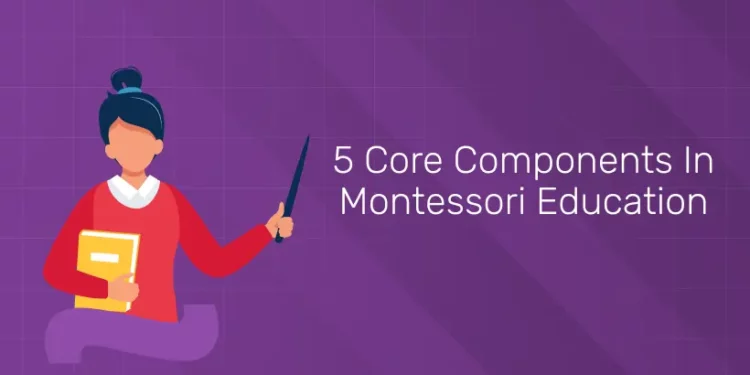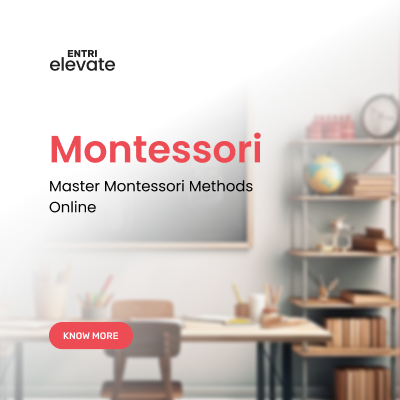Table of Contents
Dr. Maria Montessori created the Montessori Method of teaching after seeing firsthand how well-prepared an environment may be for learning when children are allowed to educate themselves. The Montessori educational approach is still well-liked by educators and students today, a century after it was developed. Despite changes in national education systems across the globe, the core components in Montessori method have endured and are still applicable today.
Here we are providing the five core elements of montessori education. Before going through the core elements one should know about the method of Montessori.
Learn the Montessori philosophy, classroom management techniques, and hands-on activities!
What is The Montessori Method?
The Montessori method is an educational strategy that supports children’s growth in the four developmental areas of early childhood education: cognitive, language, social-emotional, and physical. Children are guided through self-directed and self-motivated learning, activities, and play. Maria Montessori, an Italian physician and educator, is credited with creating it. Having studied human development from conception to maturity, she created the whole child approach, which supports childhood development by providing children with the framework and resources they require for success both within and outside of the classroom.
5 Core Components In Montessori Education
1: What is the primary focus of the first plane of development in the Montessori method?
The Montessori approach aims to lay a solid foundation for children so they can grow into driven, self-directed learners who, as they pursue further education and growth, will eventually become successful adults. Preschoolers may be able to gain independence, become more confident in their abilities, and establish trust in the world by being in a safe, stimulating, and caring environment like a Montessori classroom.
To establish the Montessori method in the classroom, we have to consider the follwing 5 core componets of montessori education.
1. Child-Centered Learning Environment
A Montessori education encourages students to select engaging and difficult assignments that pique their interest. This promotes engagement, intrinsic drive, sustained focus, and a sense of personal and social responsibility. The layout and style of the Montessori classroom, which are intended to pique each child’s curiosity and provide them the chance to work in quiet, uncluttered areas either alone or with others, facilitate this child-directed activity.
Children are allowed to roam around and investigate in a Montessori classroom; in fact, Dr. Maria Montessori, the movement’s founder more than a century ago, built her classrooms with this idea in mind. Along with guiding students and keeping them on the path to learning, teachers also make sure that the classroom is a polite, well-organized, and productive place.
2. Trained Montessori Teachers
A Montessori teacher with the appropriate credentials knows how important it is to let kids grow organically. Based on observations of each child’s distinct interests, skills, and social, emotional, cognitive, and physical development, the teacher provides challenging and developmentally appropriate courses and materials to children within a given age range. A certified Montessori teacher is knowledgeable about both the proper and accurate use of Montessori materials in addition to the theory and philosophy of the method. They possess a strong foundation in human growth and development, the leadership abilities required to create a loving environment that both physically and mentally fosters learning, and the observational skills to mentor and push their students.
3. Multi-Age Classrooms
Montessori classrooms frequently have mixed-age groups where kids of various ages and skill levels come together to study in a welcoming, neighborhood setting. This framework promotes social-emotional development, peer mentoring, and teamwork. Younger children are motivated by the achievements and skills of their older classmates, and older children act as mentors and role models for younger ones. Students benefit from this dynamic by feeling more empathetic, cooperative, and like they belong.
Unlock your passion and shape young minds as a Montessori teacher!
4. Freedom within Limits
The idea of “freedom within limits,” in which kids are allowed the autonomy to follow their interests and make decisions within a safe and orderly environment, is one that is fostered by Montessori education. Teachers play the roles of facilitators and guides, offering children boundaries, support, and kind direction as they traverse their educational journeys. As kids become more accountable for their choices and actions, this method promotes self-reliance, self-control, and inner drive.
5. Uninterrupted Work Periods
The “uninterrupted work period” is a prolonged period of “free choice” time in Montessori classrooms that honors and celebrates individual differences in the learning process. Students are allowed to choose and complete different assignments and responsibilities at their own pace, without interruption, during the work session. The work cycle of a child consists of choosing an activity, completing it for as long as they find it interesting, tidying it up and putting it back on the shelf, and then choosing another one. Teachers give individual and small-group instruction as well as help and oversee the student’s work during the work hour. The unbroken work session promotes the growth of independence, focus, and coordination.
| Montessori Teacher Training in Different Cities |
| Montessori Teacher Training Course in Trivandrum |
| Montessori Teacher Training Course in Kollam |
| Montessori Teacher Training Course in Kochi, Ernakulam |
| Montessori Teacher Training Course in Calicut |
BE A MONTESSORI TEACHER ! ENROLL FOR FREE DEMO VIDEO !
Together, these fundamental elements of Montessori education provide a supportive and stimulating learning environment where kids are free to explore, learn, and reach their full potential as self-assured, lifelong learners.










